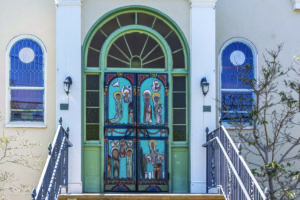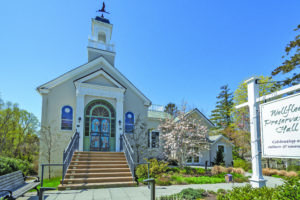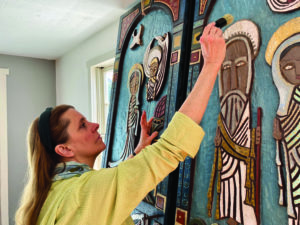WELLFLEET — As you walk down Main Street, past quaint shops with nautical-themed signs, you might be stopped in your tracks by the sight of the doors at Wellfleet Preservation Hall. The striking figures carved on them stand out against an intense blue background — stylized figures in gold, silver-white, bright greens, and deep reds.
The motifs aren’t the usual New England decorations of sailboats and marshes, says Wellfleet artist Ellen LeBow. “The doors represent Wellfleet in a different way,” she says. “They’re deceptively simplified pictures of Mary, God, angels, and saints” To her, the doors are “magical.”

LeBow is one of a small group of residents who first envisioned giving new life to the building that had once been Our Lady of Lourdes Catholic Church. The fact that the doors remained even when the building had been abandoned and was falling down is part of what makes them important, she says. And when the building was renovated to become Preservation Hall in 2011, the doors became symbolic of that spirit of renewal.
The doors were put back in place on April 26 after being restored by Wellfleet conservator Debra Dickinson. As soon as they were removed two months earlier to go to Dickinson’s workshop, Preservation Hall Director Janet Lesniak started to get calls: “When will the doors be back?”
The doors have been a landmark in Wellfleet since they were first created 46 years ago, LeBow says. Local families use them to mark their kids’ heights. Those same kids come home to the Cape to use them as the background for their wedding photos. When they have kids, they point to the doors as a way to tell Bible stories, LeBow says.
Mark Gabriele first came across the “strange but magical” doors as a teenager on summer vacation in 1977, just a year after they were originally installed. “I wrote about them in my journal,” says Gabriele. “They had an impact on me.” Some 25 years later, he returned to live in Wellfleet and started looking into who carved and painted the doors.
His research became a long-term project involving cross-country travel, finding letters, and delving into newspaper archives. Ten years later, Gabriele is still learning about the itinerant artists Johnathan Kendall and Charles McLeod.
The pair had skipped bail in California and headed east, driving across a country that was busy preparing for the bicentennial of the Declaration of Independence: planting trees, preserving historical documents, and preparing festivities. Father Jude Morgan, pastor of Our Lady of Lourdes in Wellfleet, wanted to take part in the effort by sprucing up the church. The timing was perfect for Kendall and McLeod who, having landed in Wellfleet, agreed to carve the church’s doors in exchange for being allowed to pitch a tent behind the rectory for the summer, Gabriele says.
They didn’t stay in town long. “It’s funny and fascinating,” says Gabriele. “They came here on the run. They started carving. They wanted to get everything straightened out and, before you know it, their cover was blown. They had to run again.”

Kendall traveled across the country for decades, caught in a cycle of lawbreaking, running away, and making artworks to repay people who were willing to post bail for him. Sometimes he was joined by creative partners like McLeod. Another partner was John Kreyche, whom he married. “It was one of the first gay union ceremonies ever,” Gabriele says, “in Tucson, circa 1986.”
Kendall died at age 65 in New Mexico. Gabriele’s research resulted in a 2007 exhibition at the Cape Cod Museum of Art in which various threads from Kendall’s life story were woven together.
People who knew Kendall often described him as volatile or unstable, Gabriele says, “but a lot of people respected him and his talent. He could sit down and discipline himself artistically, creating some very large and beautiful pieces. He was an outsider artist, and all he really wanted to do was carve.”
Most of Kendall’s art was religious, and after seeing many of his works in different settings across the country, Gabriele noticed that many pieces depicted scenes from the story of Jonah and the Whale.
“Jonah was trying to escape his destiny,” Gabriele says. “Maybe that resonated with him.”
In 1987, when the church’s new pastor, Bernard Kelly, considered replacing the doors because he didn’t appreciate their misshapen angels and gnarled saints, his parishioners resisted. The story made the front page of the Cape Cod Times. (Kelly later made his own headlines when, in 2003, during an investigation into his relationship with a murder suspect, it was discovered that he had embezzled hundreds of thousands of dollars in church funds in both Wellfleet and Falmouth.)

In 2000, when the Diocese of Fall River decided to close the building and sell it, many items of church property, such as the pews, went up for sale. Parishioners again insisted that the doors not be removed from the building.
“The fact that the community did not want to see these doors gone is such a wonderful, quintessential Wellfleet story,” Debra Dickinson says.
Her restoration process took longer than expected because preserving wood is tricky, especially if the wood is highly porous, roughly carved, and unprimed. That was the case with Kendall’s work. The challenge is greater if the wood is exposed to the elements, Dickinson says.
With careful attention and practiced technique, and an assist from her daughter, Emeline, after a process Dickinson calls “part detective work and part balancing act,” the doors now reflect the original artists’ intent and colors.
Dickinson aims to retain the character that comes with age while ensuring the doors are adequately protected. This was done by removing rot, treating existing wood, replacing lost wood, replacing any newer colors with original colors, and applying a protective exterior sealant.
“The doors represent the spirit of Wellfleet that made the arduous process rewarding,” Dickinson says. “I was preserving a piece of the town.”
